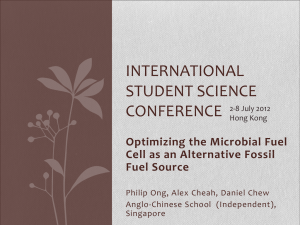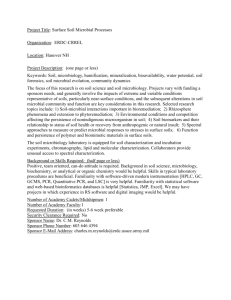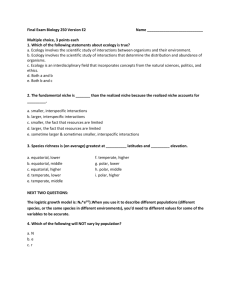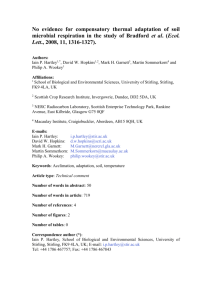McMurdie PJ, Holmes S (2013) Waste not, want not: Why rarefying
advertisement
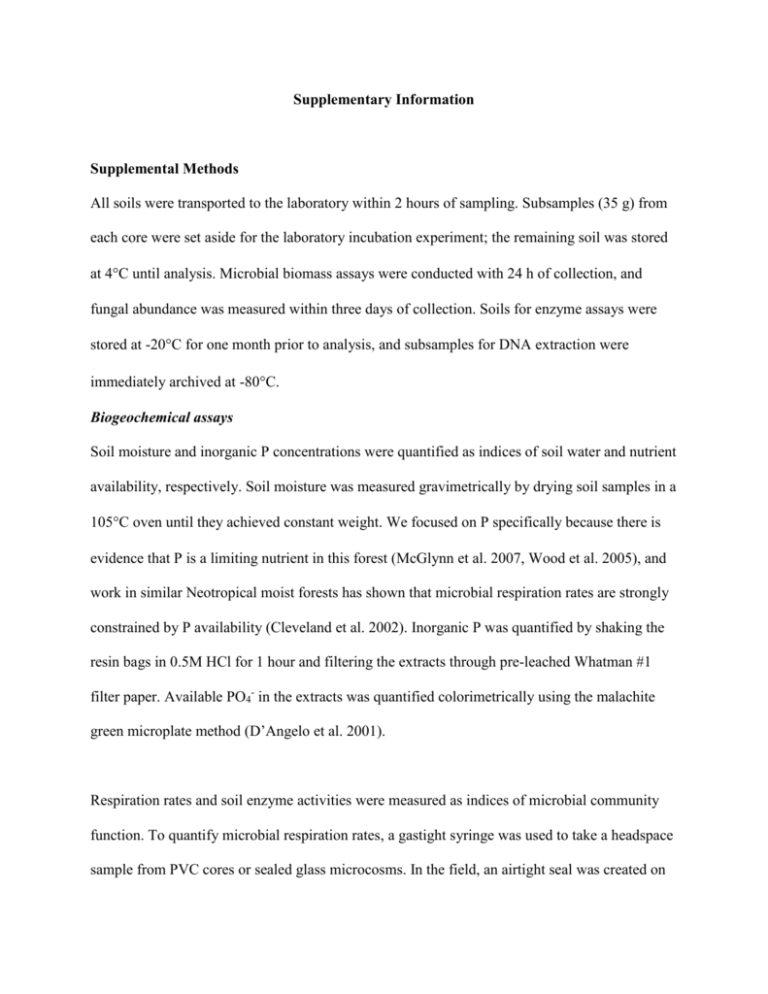
Supplementary Information Supplemental Methods All soils were transported to the laboratory within 2 hours of sampling. Subsamples (35 g) from each core were set aside for the laboratory incubation experiment; the remaining soil was stored at 4C until analysis. Microbial biomass assays were conducted with 24 h of collection, and fungal abundance was measured within three days of collection. Soils for enzyme assays were stored at -20C for one month prior to analysis, and subsamples for DNA extraction were immediately archived at -80C. Biogeochemical assays Soil moisture and inorganic P concentrations were quantified as indices of soil water and nutrient availability, respectively. Soil moisture was measured gravimetrically by drying soil samples in a 105C oven until they achieved constant weight. We focused on P specifically because there is evidence that P is a limiting nutrient in this forest (McGlynn et al. 2007, Wood et al. 2005), and work in similar Neotropical moist forests has shown that microbial respiration rates are strongly constrained by P availability (Cleveland et al. 2002). Inorganic P was quantified by shaking the resin bags in 0.5M HCl for 1 hour and filtering the extracts through pre-leached Whatman #1 filter paper. Available PO4- in the extracts was quantified colorimetrically using the malachite green microplate method (D’Angelo et al. 2001). Respiration rates and soil enzyme activities were measured as indices of microbial community function. To quantify microbial respiration rates, a gastight syringe was used to take a headspace sample from PVC cores or sealed glass microcosms. In the field, an airtight seal was created on the PVC cores using flat metal lids equipped with rubber septa and lined with vacuum grease (Dow Corning.) Air was sampled after 15 minutes. To account for temporal variability in respiration rates, each field core was sampled twice over a 24-hour period, and the resulting respiration values were averaged for the final analysis. Because the mesh cores were not airtight, it was not possible to sample these cores for respiration rates in the field. In the laboratory, microcosms were sealed for 24 hours before sampling the headspace. All gas samples were stored in 12-ml borosilicate vials (Whatman, Kent, UK) sealed with gas-impermeable butyl rubber septa (Geo-Microbial Technologies Inc., Ochelata, OK) placed in screw-top lids until analysis on a SRI 8610C gas chromatograph (SRI Instruments, Santa Monica, CA). Cumulative respiration over the course of the microcosm experiment was calculated using the formula n R T i i 0 i where n is the duration (days) of the microcosm experiment, Ri is the mean respiration rate (µmol CO2 g-1 h-1) between two successive respiration measurements, and Ti is the time (hours) between the two respiration measurements (Liu et al. 2009). We also calculated massspecific respiration (an index of microbial carbon use efficiency) by dividing respiration rate (µmol CO2 g-1 h-1 by microbial biomass (µg C g-1) at each timepoint. Enzyme assays were performed on 5-g soil samples according to standard colorimetric protocols (Sinsabaugh et al. 1993). Activities of acid phosphatase (AP) and beta-glucosidase (BG), two enzymes involved in carbon and phosphorus cycling, respectively, were quantified by incubating litter with p-nitrophenol labeled substrates for 1-2 hour and measuring concentration of released p-nitrophenol on a spectrophotometer at 410 nm. Total microbial biomass and fungal hyphal abundance were quantified as indices of microbial abundance. Fungal hyphal lengths were counted by mixing 5 g of fresh soil with 500 ml of 5% sodium hexametaphosphate, filtering 15-ml aliquots through two replicate 0.45-m nitrocellulose filters, and staining with acid fuchsin (Brundrett et al. 1994). Hyphal abundance was quantified using the magnified grid-intersection method (McGonigle et al. 1990) at 160x with 100 fields of view per sample. Microbial biomass was measured using the chloroform fumigation and direct extraction method (Brookes et al. 1985, Scott-Denton et al. 2006), whereby organic C was extracted from 5-g unfumigated and 5-g chloroform-fumigated soils with 25 ml of 0.5M K2SO4. The filtered extracts were frozen until analysis on an Apollo 9000 TOC Analyzer (Teledyne Tekmar, Mason, OH). Microbial biomass was calculated by dividing the difference in carbon concentrations between fumigated and unfumigated extracts by a conversion factor of 0.45. Quantification of microbial community structure via 454 pyrosequencing DNA was extracted from archived subsamples of each core using a MoBio PowerSoil extraction kit (MOBIO Laboratories, Carlsbad, CA). DNA extracts from each plot were quantified on a NanoDrop spectrophotometer (Thermo Scientific, Wilmington, DE) and combined within each individual combination of block, precipitation treatment, and core treatment, for a total of 24 pooled DNA samples. The pooled samples were amplified in triplicate with Invitrogen PCR Supermix (Invitrogen, Carlsbad, CA) and the primer pairs 27F/338R and EF4/fung5, which amplify variable regions of the bacterial and fungal small subunit rDNA, respectively (Nemergut et al. 2010, Smit et al. 1999). Amplicons were purified with a MoBio UltraClean PCR Clean-Up kit (MoBio Laboratories, Carlsbad, CA). To allow for multiplexing, each unique sample was ligated to a different RapidLibrary Multiplex Identifier (MID barcode; Roche, Basel, Switzerland) using the NEBNext 454 Rapid Library Kit (New England Biolabs, Ipswitch, MA). The barcoded amplicons were then purified of fragments < 300 bp using Agencourt AmPure XP magnetic beads (Beckman Coulter, Brea, CA). The concentration of DNA in each sample was quantified using Qubit fluorometric assays (Life Technologies, Grand Island, NY), and bacterial and fungal amplicons were subsequently pooled in equimolar concentrations. Finally, amplicons were sequenced on a Roche 454 FLX sequencer with titanium chemistry (Roche 454 Life Sciences, Branford, CT) at the University of Texas at Austin Genome Sequencing and Analysis Facility. Sequence data were analyzed using the QIIME pipeline (Caporaso et al. 2010). The data were quality filtered to exclude any sequences with quality scores below 25, sequences with fewer than 150 bp, or sequences with an anomalous barcode (either mismatches or incorrect length). All singletons unique to the entire dataset were removed, as these are likely to represent sequence errors (Kunin et al. 2010), and chimeras were removed with USEARCH 6.1 (Edgar 2010). Operational taxonomic units (OTUs) were defined at 97% sequence similarity using the UCLUST algorithm (Edgar 2010). Representative sequences from each OTU were searched against the RDP (Wang et al. 2007) and SILVA (Quast et al. 2013) databases to identify any non-bacterial or non-fungal data (‘unclassified’ or metazoan sequences), which were eliminated from the dataset. All samples were rarefied before analysis in order to avoid bias in sampling effort among samples. Because soils from one block (Block 6, the driest block) did not yield more than 500 bacterial or fungal sequences, even after re-amplification and re-sequencing, all samples were rarefied to 500 sequences. Recently, McMurdie and Homes (2013) suggest that rarefaction may bias analyses of community sequence data; however, all statistical results reported in this manuscript were consistent when performed on rarefied data vs. samples with unequal library sizes. Representative sequences from each OTU were used to build phylogenetic trees using the default settings in the Simultaneous Alignment and Tree Estimation program (SATé II v 2.2.7, Liu et al. 2012). References Brookes PC, Landman A, Pruden G, Jenkinson DS (1985) Chloroform fumigation and the release of soil nitrogen: a rapid direct extraction method to measure microbial biomass nitrogen in soils. Soil Biology and Biochemistry, 17, 837-842 Brundrett M Melville L Peterson L (eds) (1994) Practical Methods in Mycorrhiza Research Mycologue Publications, Guelph, Canada Cleveland C, Townsend A, Schmidt S (2002) Phosphorus limitation of microbial processes in moist tropical forests: evidence from short-term laboratory incubations and field studies, Ecosystems, 5, 680-691 D'Angelo E, Crutchfield J, Vandiviere M (2001) Rapid, sensitive microscale determination of phosphate in water and soil. Journal Of Environmental Quality, 30, 2206-2209 Edgar RC (2010) Search and clustering orders of magnitude faster than BLAST. Bioinformatics, 26, 2460-2461 Kunin V, Engelbrektson A, Ochman H, Hugenholtz P (2010) Wrinkles in the rare biosphere: pyrosequencing errors can lead to artificial inflation of diversity estimates. Environmental Microbiology, 12, 118-123 Liu K, Warnow TJ, Holder MT, Nelesen SM, Yu J, Stamatakis AP, Linder CR (2012) SATé-II: Very fast and accurate simultaneous estimation of multiple sequence alignments and phylogenetic trees. Systems Biology, 61, 90-106 Liu L, King JS, Booker FL, Giardina CP, Allen HJ, Hu S (2009) Enhanced litter input rather than changes in litter chemistry drive soil carbon and nitrogen cycles under elevated CO2: a microcosm study, Global Change Biology, 15, 441-453 McGlynn T, Salinas D, Dunn R, Wood T, Lawrence D, Clark D (2007) Phosphorus limits tropical rain forest litter fauna. Biotropica, 39, 50-53 McGonigle T, Miller M, Evans D, Fairchild G, Swan J (1990) A new method which gives an objective measure of colonization of roots by vesicular-arbuscular mycorrhizal fungi. New Phytologist, 115, 495-501 McMurdie PJ, Holmes S (2013) Waste not, want not: Why rarefying microbiome data is inadmissible. arXiv.org, arXiv:1310.0424. Accessed 21 October 2013. Quast C, Pruesse E, Yilmaz P, Gerken J, Schweer T, Yarza P, et al. The SILVA ribosomal RNA gene database project: improved data processing and web-based tools. Nucleic Acids Research, 41, D590-D596 Scott-Denton LE, Rosenstiel TN, Monson RK (2006) Differential controls by climate and substrate over the heterotrophic and rhizospheric components of soil respiration. Global Change Biology 12, 205-216. Sinsabaugh RL, Antibus RK, Linkins AE, McClaugherty CA, et al (1993) Wood decomposition: nitrogen and phosphorus dynamics in relation to extracellular enzyme activity. Ecology, 74, 1586–1593 Wang Q, Garrity GM, Tiedje JM, Cole JR (2007) Naïve Bayesian classifier for rapid assignment of rRNA sequences into the new bacterial taxonomy. Applied and Environmental Microbiology, 73, 5261-5267 Wood T, Lawrence D, Clark D (2005) Variation in leaf litter nutrients of a Costa Rican rain forest is related to precipitation. Biogeochemistry, 73, 417-437 Table S1. Spearman correlation matrix for relationships among bacterial and fungal NMS coordinates, in situ soil moisture (‘GSM’), fungal hyphal abundance, microbial biomass carbon (‘MBC’), acid phosphatase (AP) and beta-glucosidase (BG) activities, respiration rate (‘CO2’), and soil inorganic P. Significant ρ values (P ≤ 0.05) are shown in bold. Bac2 Fung1 Fung2 GSM hyphae MBC AP BG CO2 Pinorg -0.16 0.06 0.55 -0.43 Bac1 0.85 -0.73 -0.59 -0.69 -0.46 0.09 Bac2 Fung1 -0.18 -0.36 -0.65 0.10 -0.50 0.25 0.17 0.11 -0.05 -0.05 -0.65 -0.44 -0.09 0.46 0.66 -0.69 -0.32 -0.66 -0.69 -0.03 0.22 -0.11 0.06 -0.47 -0.34 0.11 0.55 0.43 0.61 0.66 0.41 -0.10 0.38 0.51 0.44 0.34 0.79 0.26 -0.47 0.41 -0.22 Fung2 GSM Hyphae MBC AP BG CO2 0.10 -0.23 -0.85 -0.05 Table S2. Summaries of regressions between phylum-level relative abundance of bacteria and gravimetric soil moisture across plots. Only significant relationships are shown. Phylum Actinobacteria Elusimicrobia FCPU426 (Candidate division) Planctomycetes -Proteobacteria -Proteobacteria WPS (Candidate division) Slope -0.07266 0.00796 0.00555 0.00426 0.02393 0.03645 -0.04554 P 0.021 <0.001 0.010 0.011 0.003 0.044 0.039 Table S3. Repeated-measures ANOVA for the effects of field precipitation treatment (Precip), laboratory soil moisture treatment (Moisture), and their interaction on microbial biomass and soil respiration rate, measured over time. P-values are corrected to account for violations of sphericity in the respiration data (Greenhouse-Geisser ε = 0.74). Respiration Microbial Biomass Factor df MS F P df MS F P Between subjects Precip 1 0.006624 8.53 0.007 1 286957 0.78 0.386 Moisture 2 0.001935 2.49 0.099 2 25552675 Precip*Moisture 2 0.002653 3.42 0.046 Error Within subjects Time 30 0.000776 2 30 557732 370214 9988924 47.03 <0.001 3 6 6 90 0.032 0.736 0.001 0.076 1 Time*Precip Time*Moisture Time*Precip*Moisture Error 3.48 0.34 6.28 2.16 1 2 2 30 263395 2076472 44203 212404 1.24 0.274 9.77 <0.001 0.21 0.813 3 0.001095 0.000106 0.001972 0.000679 0.000314 69.02 <0.001 1.51 0.238 Figure S1. Percent change in the relative abundance of each bacterial phylum in the precipitation exclusion treatment relative to control. Asterisks indicate a significant difference between treatments in planned comparison tests. Phylum Chlorobi (not shown) exhibited an 89% decrease in a relative abundance, but this was driven entirely by reductions in Block 3.

